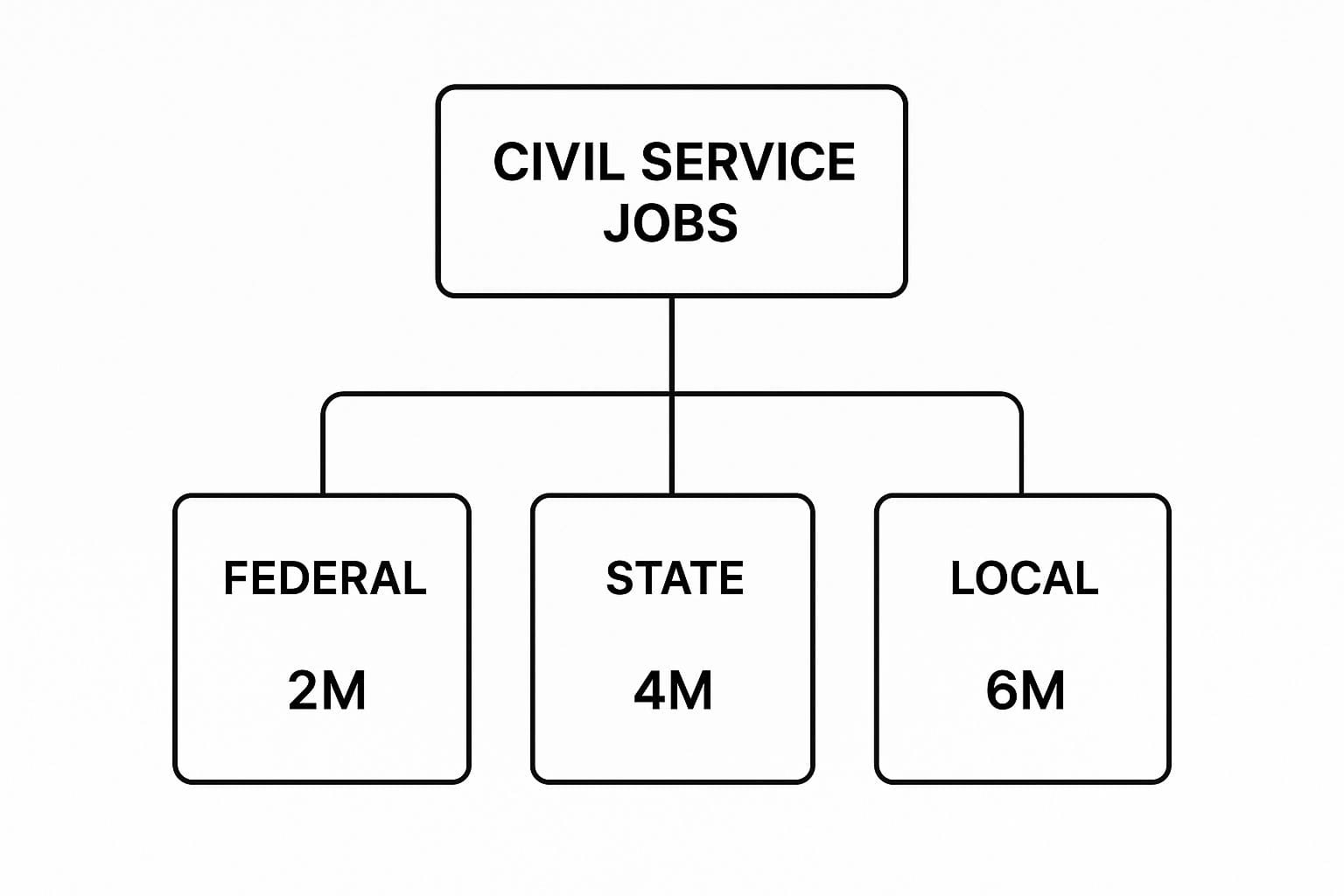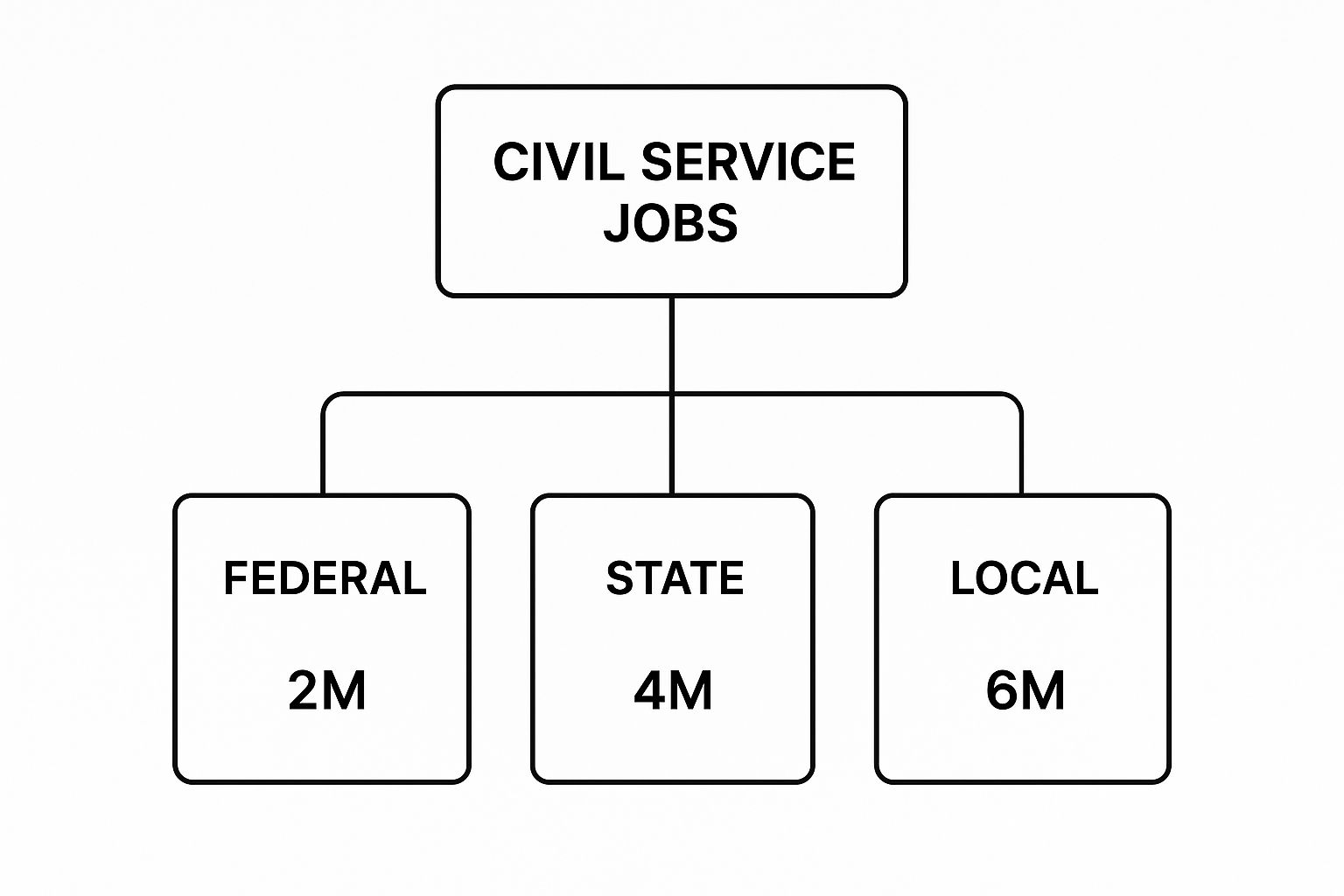Jobs Civil Service: Your Complete Guide to Landing a Public Sector Role
Learn how to secure jobs civil service with our expert guide. Tips on applications, exams, and building a successful public sector career. Click now!

Jobs Civil Service: Your Complete Guide to Landing a Public Sector Role
Securing a civil service job is a highly achievable goal, and this guide provides a practical, step-by-step roadmap to get you there. The key to success is learning how to translate your existing skills and experience into the specific language of civil service competencies, particularly using the STAR method for your application and interview. By following the actionable advice in this guide—from finding the right roles and crafting powerful behaviour examples to acing the unique tests and interviews—you can successfully navigate the process and build a rewarding career with a tangible public impact.
The real key? It's all about learning how to translate the skills and experience you already have into the specific language of civil service competencies. And that's exactly what we're going to show you how to do.
Your Path to a Career in Public Service
Thinking about a job in the civil service opens the door to a surprisingly diverse world of opportunities that genuinely shape society. It's not one single type of role; it's a massive collection of careers spanning everything from national policy and digital technology to the frontline services people rely on every day.
Think of the civil service as the operational engine of the government. Just like any complex engine, it needs a huge array of different skills and talents to run smoothly. This guide is built to be your practical companion on this journey, breaking down the entire process into clear, manageable steps—from your first curious search to your first day in a new role.
Understanding the Scale of Opportunity
The sheer number of people working in public service really highlights the scope of careers available. The infographic below gives you a great visual breakdown of how civil service jobs are distributed across federal, state, and local governments in the U.S.

As you can see, the largest chunk of roles is actually at the local level. This means there are tons of diverse opportunities to make a difference right in your own community.
The story is similar in the UK, where the workforce is both substantial and growing. As of March 2025, the UK Civil Service employed 549,660 people, which is a 1.22% increase from the previous year.
What's really interesting is that this growth is happening more and more outside of London. Regions like the North West, for instance, added nearly 1,900 employees, pointing to a clear trend toward regional career opportunities.
The secret to a successful application isn't just listing what you've done. It's about showing how your actions and experiences align with core public service values like impartiality, integrity, and objectivity.
Preparing for a Public Sector Role
If you're setting your sights specifically on government and public sector services, a qualification like an Access to Higher Education Diploma in Public Sector Services and Policing can give you a fantastic, structured entry point. These programs are specifically designed to build the foundational knowledge you'll need to excel.
To give you a clearer picture of the journey ahead, here's a quick overview of the typical path into a civil service career.
Civil Service Career Path Overview
This table breaks down the key stages you'll navigate when applying for a civil service job, from initial research to securing your position.
| Stage | Key Action | Focus Area |
|---|---|---|
| Exploration | Research different departments and roles. | Identify roles that match your skills and interests. |
| Preparation | Tailor your CV and write behaviour examples. | Align your experience with civil service competencies. |
| Application | Complete and submit the online application form. | Pay close attention to detail and deadlines. |
| Assessments | Complete online tests (numerical, verbal, etc.). | Practice common tests to improve speed and accuracy. |
| Interview | Attend a competency-based or strength-based interview. | Clearly articulate your skills using the STAR method. |
| Appointment | Undergo security checks and receive a formal offer. | Provide necessary documentation promptly. |
Each step is a chance to demonstrate your suitability, so approaching the process with a clear strategy is crucial for success.
Build Your ATS-Optimized CV
Put these resume strategies into action with our AI-powered CV builder that ensures ATS compatibility
Create Your CV NowUnderstanding the World of Government Roles
When you hear "civil service," what comes to mind? For many, it's images of endless paperwork and sleepy administrative offices. But that picture is decades out of date. The reality is far more dynamic and incredibly diverse.
Think of the government less like a single, monolithic entity and more like a massive global corporation with dozens of highly specialized divisions. Every department and agency has its own unique mission, creating a surprisingly vast landscape of career opportunities. Your skills—whether in tech, communications, finance, or project management—have a place here.
Figuring out this structure is the first real step to targeting your job search. Instead of just vaguely looking for a "government job," you can start pinpointing the exact departments where your expertise will make a genuine impact.

The Core Functions of Civil Service Roles
While the specific day-to-day tasks can vary wildly, most civil service jobs fall into a few key areas. Getting a handle on these helps you match your own career goals with what the government actually needs to get done.
- Policy and Strategy: These are the big-picture thinkers shaping the future. Policy professionals work on everything from drafting national healthcare initiatives to creating environmental regulations. They're the researchers, analysts, and advisors who build the evidence base for government decisions.
- Operational Delivery: This is the largest and most visible part of the civil service—the people delivering services directly to citizens. Think of the staff at a job centre helping people find work or the consular teams assisting nationals abroad. This is where the government's work meets the public.
- Specialist and Corporate Services: Just like any huge organization, the government needs a small army of experts to keep things running smoothly. This includes crucial roles in IT, human resources, finance, law, and communications. If you have a professional skill, chances are the civil service needs it.
From Public-Facing Services to Specialized Expertise
The sheer diversity of roles is staggering. For instance, a communications expert might be at the Department of Health, crafting public health campaigns. An IT specialist could be at the Ministry of Defence, building out critical cybersecurity infrastructure. A grants manager might find their home in the Department for Science, overseeing funding for groundbreaking research projects.
This variety is a global phenomenon. In OECD countries, general government employment averaged 18.4% of the total workforce in 2023. This figure highlights just how stable and significant the public sector is, often providing a bedrock of employment even when the private sector slows down.
The numbers can be even more dramatic depending on national priorities. Some European nations see over 30% of their entire workforce in the public sector, showing its central role in social and economic life. You can dig deeper into these global employment trends through the World Population Review's country rankings.
The key takeaway is this: stop thinking about a single "civil service" and start exploring the specific departments and agencies. Each has its own culture, mission, and required skills, offering you a real chance to find the perfect fit.
Matching Your Skills to Government Departments
So, how do you make this practical? Start by mapping your skills to specific government functions.
Are you a data analysis whiz? The Treasury or national statistics offices would be a natural fit. Do you have a passion for community engagement? Look into roles at a local government authority or a department focused on social services.
By understanding the distinct roles within the government's vast machinery, you transform from a general applicant into a targeted, high-value candidate. This insight allows you to speak the language of the specific department you're applying to, showing them you truly get their mission and can contribute from day one.
How to Navigate the Application Process
The civil service application process has a reputation for being rigid, but it's far from a secret code. Think of it as a series of logical steps, each built to give every candidate a fair shot. This section is your roadmap, turning what feels like an intimidating journey into a set of clear, actionable tasks. We'll cover everything from finding the right opening to mastering the STAR method—the practical details that truly make a difference.
Finding and Targeting the Right Roles
Your first move is to get plugged into the right channels. For UK applicants, the central hub is the Civil Service Jobs website. In the United States, USAJOBS is its counterpart. Don't just browse these sites passively; use the tools they offer.
Set up personalised job alerts with keywords and department names that match your skills and passions. This simple step puts you at the front of the line, ensuring you see new opportunities the moment they drop. It's a small effort that gives you a massive head start.
When you're applying for several roles at once, staying organized is non-negotiable. Using a dedicated tool to keep everything straight prevents missed deadlines and mix-ups. A simple job application tracker can be a lifesaver, giving you one central place to manage application dates, interview notes, and follow-ups.
Deconstructing the Job Description
Once a promising role catches your eye, the job description becomes your most critical document. It's not just a list of duties; it's a blueprint of their ideal candidate. Your mission is to break it down and find the core competencies, which the UK system calls "behaviours."
These behaviours are the specific skills and mindsets hiring managers are looking for. You'll often see things like:
- Seeing the Big Picture: Can you understand how your work connects to broader government goals?
- Making Effective Decisions: Are you able to use evidence and good judgment to make timely, sound calls?
- Working Together: This is all about building supportive, collaborative relationships with colleagues and partners.
- Delivering at Pace: Do you have the drive to push projects forward, take ownership, and get things done?
Go through the job description and highlight these keywords. This list is the foundation for your entire application, dictating how you'll write your personal statement and choose your examples.
Crafting Powerful Behaviour Examples with STAR
This is where the rubber meets the road. Simply saying "I'm a good leader" will get you nowhere. You have to prove it with hard evidence, and the best way to do that is with the STAR method.
The STAR method gives your examples a clear, compelling structure:
- Situation: Set the scene. Where were you, and what was the challenge?
- Task: What was your specific responsibility? What outcome were you supposed to deliver?
- Action: Detail the steps you took. This is the most important part—focus on your personal contribution. Use "I," not "we."
- Result: What happened because of your actions? Back it up with numbers, percentages, or concrete feedback whenever you can.
Think of each STAR example as a mini-story with you as the hero. It's your chance to turn a past success into a powerful narrative that directly answers the recruiter's fundamental question: "Can you do this job for us?"
Let's look at how this transforms a weak example for the "Delivering at Pace" behaviour.
Before: "I was part of a team that had to complete a project on a tight deadline, and we worked hard to get it done on time."
This is vague and forgettable. Now, let's power it up with the STAR method.
After (STAR Method):
- Situation: Our team was launching a new public information webpage, but a key developer resigned just two weeks before the deadline.
- Task: I was tasked with taking over the remaining development, coordinating with the content team, and ensuring we still hit the original launch date.
- Action: I immediately mapped out a revised project plan, set up daily 15-minute check-ins with the writers, and personally coded the final components to close the gap.
- Result: The webpage launched precisely on schedule with zero errors. It attracted over 10,000 unique visits in the first week, and we received commendations from senior management for hitting the critical deadline under pressure.
See the difference? The second example is specific, action-oriented, and proves your capability beyond a doubt. Mastering this technique will elevate your application from a simple resume to a compelling portfolio of your professional wins.
Passing Civil Service Tests and Interviews
This is where the rubber meets the road. Your performance on the standardized tests and structured interviews is what truly separates you from the pack. It's not just a formality; it's a carefully designed process to see how you think, act, and solve problems when it counts.
Succeeding here is all about smart preparation. You need to understand what the assessors are actually looking for and then confidently show them you've got it.
Think of the online assessments as the first hurdle. They're an objective filter, designed to measure the core aptitudes needed for many jobs civil service roles. The goal isn't to trick you, but to get a clear picture of your natural strengths. With the right strategy and a bit of practice, you can walk into these tests with a real advantage and sail through to the next stage.

Cracking the Online Assessments
Almost as soon as you hit "submit" on your application, you'll likely be asked to complete a series of online tests. The exact mix will depend on the role, but you can bet you'll run into a few of these common types.
- Verbal Reasoning Tests: These test how well you can pull meaning from written information. You'll read a short passage and then have to decide if statements are true, false, or if you just can't tell based only on the text provided.
- Numerical Reasoning Tests: Your job here is to make sense of data in graphs, charts, and tables. It's less about hardcore math and more about your ability to quickly find the right numbers and use them to solve a problem.
- Situational Judgement Tests (SJTs): These are pretty unique to the civil service. You'll be presented with realistic workplace scenarios and asked to pick the most and least effective responses. They're a clever way to see if your professional judgment lines up with core civil service values.
The secret to all of these? Practice. The more familiar you are with the format and timing, the more confident and speedy you'll be. Most official government career sites have free practice tests—they are an invaluable resource.
Mastering the Civil Service Interview
Make it past the online tests, and you'll score an interview invitation. This is your moment to bring your application to life and show the person behind the paper. Civil service interviews are highly structured and usually fall into one of two categories. Knowing which one you're walking into is half the battle.
A behavior-based interview drills down on your past experiences, expecting you to use that STAR method we talked about to prove you have the right skills. A strength-based interview, on the other hand, is trying to figure out what you genuinely enjoy and excel at. Questions will sound more like, "What kind of work gives you energy?" or "Do you get more satisfaction from starting a new project or seeing one through to the very end?"
The backdrop to all this is an ever-changing world. The World Economic Forum's Future of Jobs Report 2025 highlights challenges like slower economic growth and high living costs impacting the global labor market. It notes a global unemployment rate of 4.9% in early 2025, the lowest since 1991, though this varies by region. These massive trends directly shape public sector jobs as governments rush to meet new societal needs, often boosting demand for roles in tech and policy.
Preparing Your Answers
No matter the interview style, your prep should be anchored to the job description's success profile. Get ahead of the questions by breaking down each required behavior or strength and lining up a compelling example from your own career.
- Map Your Stories: For every key competency—like "Working Together" or "Making Effective Decisions"—have at least two solid STAR examples ready to go.
- Quantify Your Impact: Numbers speak louder than words. Saying you "improved team efficiency by 15%" hits much harder than simply saying you "made things better."
- Practice Out Loud: This is non-negotiable. Rehearse your answers, either with a friend or just in front of a mirror. It helps you iron out the kinks, check your timing, and make sure your stories land clearly and concisely.
While you're prepping for the specifics of the civil service, it never hurts to brush up on general interview skills. This guide to Top HR Interview Questions and Answers is a great resource.
And finally, don't forget that none of this matters if your CV gets filtered out before a human even sees it. Make sure your application materials are perfectly optimized by checking out our guide on creating an ATS-friendly resume.
Building a Standout Civil Service CV
Even when applications lean heavily on forms, a sharp, well-crafted CV is your secret weapon. This is especially true for specialized or senior roles. The trick is to stop thinking like you're applying for a corporate job and start speaking the language of public service.
This means you need to frame every single accomplishment around core civil service competencies. Quantify your impact with real numbers and show that your values line up perfectly with what public service is all about. This way, your CV doesn't just list what you've done—it tells a compelling story about why you're the right person for the job.
Translating Your Experience for the Public Sector
The skills you have are almost certainly what the civil service is looking for. The real challenge is in the translation. A corporate win focused on boosting profits needs a new frame—one that highlights public value, efficiency, or better collaboration.
Think of it like being bilingual. You know what you want to communicate, but you have to say it in the language your audience actually speaks. For a civil service recruiter, that language is built entirely around the Success Profiles framework.
To get started, pull up your current CV and the job description side-by-side. For every bullet point on your resume, ask yourself: "How does this prove I'm good at 'Working Together' or 'Making Effective Decisions'?" That one simple question is the key to reshaping your entire narrative.
Quantifying Achievements with a Public Service Focus
Vague statements are the enemy. "Managed a project" is completely forgettable.
But what about this? "Managed a cross-departmental project, delivering it 10% under budget and improving service accessibility for 5,000 citizens." That's powerful. It sticks. Numbers turn your claims into cold, hard evidence.
Look for opportunities to add concrete metrics:
- Efficiency Gains: Did you save time or money? Say by how much.
- Scale of Work: How many people were on your team? What was the budget size? How many cases did you handle?
- Stakeholder Management: Mention the number of departments or external partners you worked with.
- Positive Outcomes: If you can, connect your work to better public satisfaction scores or service delivery stats.
This focus on measurable results directly proves you can deliver value, which is priority number one in any government role.
Your CV is more than just a history of your jobs; it's a strategic marketing document. Every bullet point should be engineered to prove you have the specific competencies needed for your target civil service role.
Translating Corporate Skills to Civil Service Competencies
So, how do you actually reframe those corporate achievements? The table below gives you a few practical examples of how to translate common private-sector skills into the language that clicks with public sector hiring managers.
| Corporate Skill/Achievement | Civil Service Competency | Example Rephrasing for Application |
|---|---|---|
| Increased quarterly sales by 15%. | Delivering at Pace | "Exceeded performance targets by 15% for three consecutive quarters by implementing a new workflow, ensuring project milestones were met ahead of schedule." |
| Led a product launch team. | Leadership | "Led a diverse team of 8 specialists to launch a new service, fostering a collaborative environment that met all key deliverables on time." |
| Managed client relationships. | Working Together | "Built and maintained strong working relationships with over 20 external stakeholders to ensure alignment and successful project outcomes." |
| Analyzed market trends for a new product. | Seeing the Big Picture | "Conducted in-depth analysis of user data to inform strategic planning, ensuring our team's work aligned with wider organisational objectives." |
This strategic reframing is absolutely essential. It's also a skill you'll need as you move through the application process.
For a deeper dive into applying this mindset, check out our guide on how to write a civil service personal statement with examples. Once you master this translation, you'll find your application speaks directly to what recruiters are looking for.
For those looking to create compelling civil service personal statements, the UK Civil Service personal statements tool at CV Anywhere can help you craft tailored content that matches Civil Service Success Profiles and competency frameworks.
How to Advance Your Public Sector Career
Landing a civil service job is a massive accomplishment, but honestly, it's just the starting line. The real prize is building a long, impactful career, and the good news is the public sector is built to help you do just that. Getting ahead here isn't about just waiting your turn for a promotion; it's about actively learning the system and using it to grow—from your first day in an entry-level role all the way to senior leadership.
This means getting to grips with the grade structure, finding mentors who can guide you, and strategically moving around internally to build a skill set that's both deep and wide. Your long-term career path starts with the choices you make right now.

Understanding the Grade Structure
Think of the civil service career path less like a single ladder and more like a structured trail with clear signposts. Each grade represents a specific level of responsibility and expertise. In the UK system, for example, you might start as an Administrative Officer (AO), move to Executive Officer (EO), and climb up toward the Senior Civil Service (SCS).
Moving up isn't just about being good at your current job. It's about proving you have the behaviours and skills for the next job. Your first move should be to get familiar with the Success Profiles for the grade directly above yours. This document is essentially a roadmap showing you exactly what skills to focus on developing.
The Power of Continuous Professional Development
The civil service is huge on learning and development. Unlike some private sector jobs where training feels like an afterthought, here it's woven into the culture. Your line manager is your partner in this, working with you to create a personal development plan that aligns with your career goals.
But this goes way beyond formal training courses. The real growth comes from being proactive.
- Shadow senior colleagues: Ask to spend a day with someone in a role you're aiming for. You'll learn more in a few hours than you could from any manual.
- Volunteer for cross-departmental projects: This is the best way to get exposure to different parts of government and see how the bigger machine works.
- Attend internal seminars and workshops: Most departments offer free training on everything from project management to policy development. Take advantage of it.
A classic mistake is waiting for training to be handed to you. The people who get ahead are the ones who take ownership of their growth, actively hunting for opportunities that push their boundaries and expand what they know.
Seeking Mentorship and Building Networks
You don't have to figure all this out on your own. Most government departments have formal mentorship programs that pair up-and-coming staff with experienced senior leaders. A good mentor offers priceless guidance, helps you see the bigger picture, and can be an advocate for you when new roles open up.
Beyond that, building a strong professional network is non-negotiable. Make an effort to connect with people outside your immediate team. These relationships are your lifeline for institutional knowledge, support, and hearing about unadvertised opportunities or "stretch" assignments. A simple coffee chat with someone from another department can open doors you didn't even know existed.
A stretch assignment is a short-term project that's just a little bit beyond what you're comfortable with. Grabbing one is one of the fastest ways to prove you're ready for more responsibility. It shows initiative and a hunger to learn, and it gives you concrete experience you can talk about in your next promotion interview. Combine this with formal development and smart networking, and you've got a clear, achievable plan for a long and successful public sector career.
Got Questions About Civil Service Jobs? We've Got Answers.
Stepping into the world of civil service can feel like learning a new language. There are processes and expectations that are just… different. It's totally normal to have a ton of questions, especially if you're coming from the private sector or applying for the first time.
Think of this as your personal cheat sheet. We've tackled the most common questions we hear, breaking down the essentials so you can move forward with confidence.
What Are the Basic Eligibility Requirements?
While every single role will have its own specific checklist, there are a few non-negotiables that apply to almost all civil service jobs. These usually boil down to nationality, age, and personal character.
For instance, if you're applying in the UK, you generally need to be a UK national or hold specific types of dual citizenship. There's no upper age limit, which is great, but you do have to be old enough to have left school.
And here's a big one: you must be able to pass security vetting. Everyone goes through baseline checks to verify their identity and criminal record. For roles in sensitive areas like defence or intelligence, expect a much deeper dive into your background. Always, always read the job description's eligibility section first—it will spell out exactly what's required.
Seriously, How Long Does This Whole Process Take?
Deep breaths. Applying for a civil service job is a marathon, not a sprint. The timeline from hitting "submit" on your application to getting a final offer can easily stretch over several months. A good ballpark is anywhere from two to six months, but don't be surprised if it takes longer.
The security clearance is almost always the slowest part of the journey. It can feel like your application has vanished into a black hole, but it's a vital, non-negotiable step that protects the integrity of the government. Hang in there.
Can I Apply for More Than One Job at a Time?
Yes, you absolutely can! In fact, we recommend it. Applying for a few different roles that fit your skills is a smart move. It not only increases your odds of getting an offer but also gets you more comfortable with the unique application and interview style.
A word of caution, though: don't just spam applications. Quality beats quantity every time. Take the time to tailor your application to each specific role. A generic, copy-paste approach is a surefire way to land in the "no" pile.
What's the Biggest Difference Compared to the Private Sector?
It really comes down to the mission. The private sector is built around profit. The civil service is built around public value. That one core difference changes everything—the culture, the skills they value (like impartiality and integrity), and how success is measured.
Instead of chasing quarterly earnings, your work is directly connected to improving the lives of citizens and delivering essential services. For many people, that unique sense of purpose is the most rewarding part of the job.
Ready to create an application that truly reflects your value? CV Anywhere uses AI to help you build a modern, web-based portfolio that gets you noticed. It's the perfect way to create a professional online presence and even track who's viewing your profile. Give yourself the edge you need to land that ideal civil service role. Get started for free and see how it works.
Tags
Popular Articles
The smartest and fastest way to create a free online resume that gets noticed is by using a modern, free resume builder. These tools are designed to guide you past blank-page paralysis, using smart te...
A powerful recent graduate resume is your golden ticket to landing that first big interview. It acts as the bridge between your academic life and professional ambitions, designed to showcase your pote...
A well-crafted cv personal statement is the 30-second pitch at the top of your resume designed to immediately hook a recruiter. It's a short, punchy summary of your career highlights, top skills, and ...
Sending a thank you email after interview isn't just about being polite—it's a strategic move that reinforces your value and keeps you top-of-mind whilst hiring decisions are being made. Think of it a...
A powerful resume outline is what organizes your career story for maximum impact, making sure recruiters see your most valuable qualifications in the first few seconds. It's the essential framework—Co...